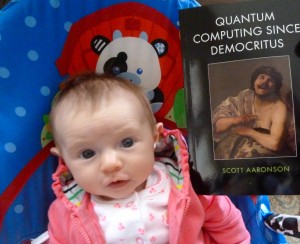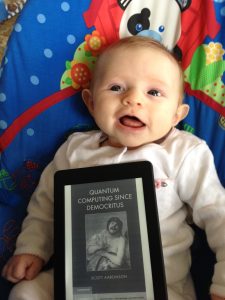Update (March 22): The Kindle edition of Quantum Computing Since Democritus is now available, for the low price of $15.40! (Not factorial.) Click here to get it from amazon.com, or here to get it from amazon.co.uk. And let me know how it looks (I haven’t seen it yet). Another Update: Just saw the Kindle edition, and the figures and formulas came out great! It’s a product I stand behind with pride.
In the meantime, I regret to say that the marketing for this book is getting crasser and more exploitative by the day.


It seems like wherever I go these days, all anyone wants to talk about is Quantum Computing Since Democritus—the sprawling new book by Scott Aaronson, published by Cambridge University Press and available for order now. Among leading figures in quantum information science—many of them well-known to Shtetl-Optimized readers—the book is garnering the sort of hyperbolic praise that would make Shakespeare or Tolstoy blush:
“I laughed, I cried, I fell off my chair – and that was just reading the chapter on Computational Complexity. Aaronson is a tornado of intellectual activity: he rips our brains from their intellectual foundations; twists them through a tour of physics, mathematics, computer science, and philosophy; stuffs them full of facts and theorems; tickles them until they cry ‘Uncle’; and then drops them, quivering, back into our skulls. Aaronson raises deep questions of how the physical universe is put together and why it is put together the way it is. While we read his lucid explanations we can believe – at least while we hold the book in our hands – that we understand the answers, too.” —Seth Lloyd
“Scott Aaronson has written a beautiful and highly original synthesis of what we know about some of the most fundamental questions in science: What is information? What does it mean to compute? What is the nature of mind and of free will?” —Michael Nielsen
“Not since Richard Feynman’s Lectures on Physics has there been a set of lecture notes as brilliant and as entertaining. Aaronson leads the reader on a wild romp through the most important intellectual achievements in computing and physics, weaving these seemingly disparate fields into a captivating narrative for our modern age of information. Aaronson wildly runs through the fields of physics and computers, showing us how they are connected, how to understand our computational universe, and what questions exist on the borders of these fields that we still don’t understand. This book is a poem disguised as a set of lecture notes. The lectures are on computing and physics, complexity theory and mathematical logic and quantum physics. The poem is made up of proofs, jokes, stories, and revelations, synthesizing the two towering fields of computer science and physics into a coherent tapestry of sheer intellectual awesomeness.” —Dave Bacon
After months of overhearing people saying things like the above—in the halls of MIT, the checkout line at Trader Joe’s, the bathroom, anywhere—I finally had to ask in annoyance: “is all this buzz justified? I mean, I’m sure the book is as deep, hilarious, and worldview-changing as everyone says it is. But, after all, it’s based off lecture notes that have long been available for free on the web. And Aaronson, being the magnanimous, open-access-loving saint that he is, has no plans to remove the online notes, even though he could really use the royalties from book sales to feed his growing family. Nor does Cambridge University Press object to his principled decision.”
“No, you don’t understand,” they told me. “Word on the street has it that the book is extensively updated for 2013—that it’s packed with new discussions of things like algebrization, lattice-based cryptography, the QIP=PSPACE theorem, the ‘quantum time travel controversy,’ BosonSampling, black-hole firewalls, and even the Australian models episode. They say it took years of painstaking work, by Aaronson and his student Alex Arkhipov, to get the notes into book form: fixing mistakes, clarifying difficult points, smoothing out rough edges, all while leaving intact the original’s inimitable humor. I even heard Aaronson reveals he’s changed his mind about certain things since 2006. How could you not want such a labor of love on your bookshelf?”
Exasperated, I finally exclaimed: “But the book isn’t even out yet in North America! Amazon.com says it won’t ship until April 30.”
“Sure,” one gas-station attendant replied to me, “but the secret is, it’s available now from Amazon.co.uk. Personally, I couldn’t wait a month, so I ordered it shipped to me from across the pond. But if you’re a less hardcore quantum complexity theory fan, and you live in North America, you can also preorder the book from Amazon.com, and they’ll send it to you when it arrives.”
Much as the hype still grated, I had to admit that I’d run out of counterarguments, so I looked into ordering a copy for myself.
 Follow
Follow

